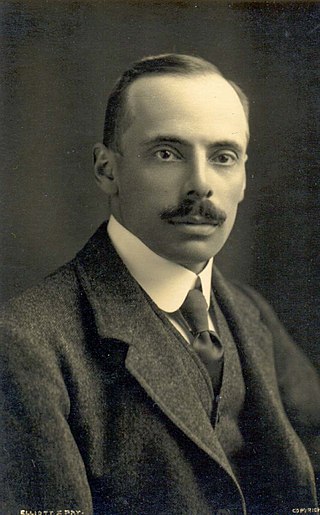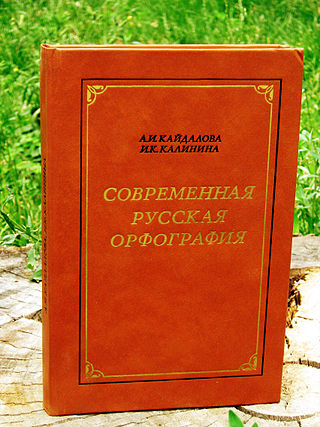The Deseret alphabet is a phonemic English-language spelling reform developed between 1847 and 1854 by the board of regents of the University of Deseret under the leadership of Brigham Young, the second president of the Church of Jesus Christ of Latter-day Saints. George D. Watt is reported to have been the most actively involved in the development of the script's novel characters, which were used to replace those of Isaac Pitman's English phonotypic alphabet. He was also the "New Alphabet's" first serious user. The script gets its name from the word deseret, a hapax legomenon in the Book of Mormon, which is said to mean "honeybee" in the only verse it is used in.

Daniel Jones was a British phonetician who studied under Paul Passy, professor of phonetics at the École des Hautes Études at the Sorbonne. He was head of the department of phonetics at University College London.
English orthography is the writing system used to represent spoken English, allowing readers to connect the graphemes to sound and to meaning. It includes English's norms of spelling, hyphenation, capitalisation, word breaks, emphasis, and punctuation.
Hanyu Pinyin, or simply pinyin, is the most common romanization system for Standard Chinese. In official documents, it is referred to as the Chinese Phonetic Alphabet. It is the official system used in China, Singapore, Taiwan, and by the United Nations. Its use has become common when transliterating Standard Chinese mostly regardless of region, though it is less ubiquitous in Taiwan. It is used to teach Standard Chinese, normally written with Chinese characters, to students already familiar with the Latin alphabet. The system makes use of diacritics to indicate the four tones found in Standard Chinese, though these are often omitted in various contexts, such as when spelling Chinese names in non-Chinese texts, or when writing non-Chinese words in Chinese-language texts. Pinyin is also used by various input methods on computers and to categorize entries in some Chinese dictionaries. Hànyǔ literally means 'Han language'—meaning, the Chinese language—while pinyin literally means 'spelled sounds'.
A spelling reform is a deliberate, often authoritatively sanctioned or mandated change to spelling rules. Proposals for such reform are fairly common, and over the years, many languages have undergone such reforms. Recent high-profile examples are the German orthography reform of 1996 and the on-off Portuguese spelling reform of 1990, which is still being ratified.
The Initial Teaching Alphabet is a variant of the Latin alphabet developed by Sir James Pitman in the early 1960s. It was not intended to be a strictly phonetic transcription of English sounds, or a spelling reform for English as such, but instead a practical simplified writing system which could be used to teach English-speaking children to read more easily than can be done with traditional orthography. After children had learned to read using I.T.A., they would then eventually move on to learn standard English spelling. Although it achieved a certain degree of popularity in the 1960s, it has fallen out of use since the 1970s.
Spelling is a set of conventions for written language regarding how graphemes should correspond to the sounds of spoken language. Spelling is one of the elements of orthography, and highly standardized spelling is a prescriptive element.
Phonetic transcription is the visual representation of speech sounds by means of symbols. The most common type of phonetic transcription uses a phonetic alphabet, such as the International Phonetic Alphabet.

Owen Wister was an American writer and historian, considered the "father" of western fiction. He is best remembered for writing The Virginian and a biography of Ulysses S. Grant.
A phonemic orthography is an orthography in which the graphemes correspond to the language's phonemes. Natural languages rarely have perfectly phonemic orthographies; a high degree of grapheme–phoneme correspondence can be expected in orthographies based on alphabetic writing systems, but they differ in how complete this correspondence is. English orthography, for example, is alphabetic but highly nonphonemic; it was once mostly phonemic during the Middle English stage, when the modern spellings originated, but spoken English changed rapidly while the orthography was much more stable, resulting in the modern nonphonemic situation. On the contrary the Albanian, Serbian/Croatian/Bosnian/Montenegrin, Romanian, Italian, Turkish, Spanish, Finnish, Czech, Latvian, Esperanto, Korean and Swahili orthographic systems come much closer to being consistent phonemic representations.
Russian orthography has been reformed officially and unofficially by changing the Russian alphabet over the course of the history of the Russian language. Several important reforms happened in the 18th–20th centuries.

Russian orthography is an orthographic tradition formally considered to encompass spelling and punctuation. Russian spelling, which is mostly phonemic in practice, is a mix of morphological and phonetic principles, with a few etymological or historic forms, and occasional grammatical differentiation. The punctuation, originally based on Byzantine Greek, was in the seventeenth and eighteenth centuries reformulated on the models of French and German orthography.
For centuries, there have been movements to reform the spelling of the English language. It seeks to change English orthography so that it is more consistent, matches pronunciation better, and follows the alphabetic principle. Common motives for spelling reform include quicker learning, cheaper learning, and making English more useful as an international auxiliary language.
Language reform is a kind of language planning by widespread change to a language. The typical methods of language reform are simplification and linguistic purism. Simplification regularises vocabulary, grammar, or spelling. Purism aligns the language with a form which is deemed 'purer'.
Inventive spelling is the use of unconventional spellings of words.
Anatoly Liberman is a linguist, medievalist, etymologist, poet, translator of poetry, and literary critic.

Yiddish orthography is the writing system used for the Yiddish language. It includes Yiddish spelling rules and the Hebrew script, which is used as the basis of a full vocalic alphabet. Letters that are silent or represent glottal stops in the Hebrew language are used as vowels in Yiddish. Other letters that can serve as both vowels and consonants are either read as appropriate to the context in which they appear, or are differentiated by diacritical marks derived from Hebrew nikkud, commonly referred to as "nekudot" or "pintalach". Additional phonetic distinctions between letters that share the same base character are also indicated by either pointing or adjacent placement of otherwise silent base characters. Several Yiddish points are not commonly used in any latter-day Hebrew context; others are used in a manner that is specific to Yiddish orthography. There is significant variation in the way this is applied in literary practice. There are also several differing approaches to the disambiguation of characters that can be used as either vowels or consonants.

Glosa is a constructed international auxiliary language based on Interglossa. The first Glosa dictionary was published 1978. The name of the language comes from the Greek root glossa meaning tongue or language.
The Simplified Spelling Board was an American organization created in 1906 to reform the spelling of the English language, making it simpler and easier to learn, and eliminating many of what were considered to be its inconsistencies. The board operated until 1920, the year after the death of its founding benefactor, who had come to criticize the progress and approach of the organization.
Feminist language reform or feminist language planning refers to the effort, often of political and grassroots movements, to change how language is used to gender people, activities and ideas on an individual and societal level. This initiative has been adopted in countries such as Sweden, Switzerland and Australia.




